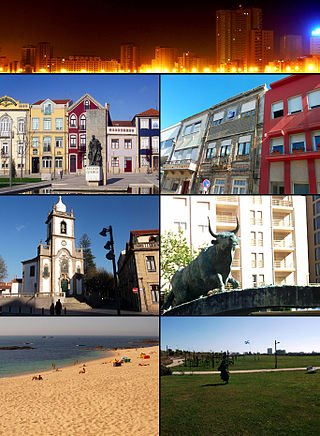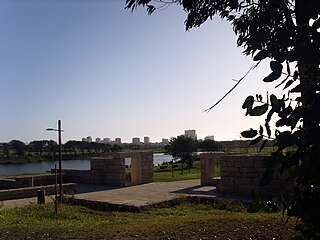
A hot spring, hydrothermal spring, or geothermal spring is a spring produced by the emergence of geothermally heated groundwater onto the surface of the Earth. The groundwater is heated either by shallow bodies of magma or by circulation through faults to hot rock deep in the Earth's crust.
Ocean thermal energy conversion (OTEC) is a renewable energy technology that harnesses the temperature difference between the warm surface waters of the ocean and the cold depths to run a heat engine to produce electricity. It is a unique form of clean energy generation that has the potential to provide a consistent and sustainable source of power. Although it has challenges to overcome, OTEC has the potential to provide a consistent and sustainable source of clean energy, particularly in tropical regions with access to deep ocean water.

Póvoa de Varzim is a Portuguese city in Northern Portugal and sub-region of Greater Porto, 30 km (18.6 mi) from its city centre. It sits in a sandy coastal plain, a cuspate foreland, halfway between the Minho and Douro rivers. In 2001, there were 63,470 inhabitants, with 42,396 living in the city proper. The city expanded southwards, to Vila do Conde, and there are about 100,000 inhabitants in the urban area alone. It is the seventh-largest urban agglomeration in Portugal and the third largest in Northern Portugal.

Hydrotherapy, formerly called hydropathy and also called water cure, is a branch of alternative medicine, occupational therapy, and physiotherapy, that involves the use of water for pain relief and treatment. The term encompasses a broad range of approaches and therapeutic methods that take advantage of the physical properties of water, such as temperature and pressure, to stimulate blood circulation, and treat the symptoms of certain diseases.

A spa is a location where mineral-rich spring water is used to give medicinal baths. Spa towns or spa resorts typically offer various health treatments, which are also known as balneotherapy. The belief in the curative powers of mineral waters goes back to prehistoric times. Such practices have been popular worldwide, but are especially widespread in Europe and Japan. Day spas and medspas are also quite popular, and offer various personal care treatments.

Richard Russell was an 18th-century British physician who encouraged his patients to use a form of water therapy that involved the submersion or bathing in, and drinking of, seawater. The contemporary equivalent of this is thalassotherapy, although the practice of drinking seawater has largely discontinued.

Balneotherapy is a method of treating diseases by bathing, a traditional medicine technique usually practiced at spas. Since ancient times, humans have used hot springs, public baths and thermal medicine for therapeutic effects. While it is considered distinct from hydrotherapy, there are some overlaps in practice and in underlying principles. Balneotherapy may involve hot or cold water, massage through moving water, relaxation, or stimulation. Many mineral waters at spas are rich in particular minerals such as silica, sulfur, selenium, and radium. Medicinal clays are also widely used, a practice known as 'fangotherapy'.

A mud bath is a therapeutic spa treatment that involves soaking in a bath of warm mud, often in a natural hot spring or geothermal pool. Mud baths have been used for centuries as a way to promote health and relaxation, and are still popular today in many parts of the world.

Póvoa de Varzim, in Portugal is an ethno-cultural entity stemming from its working classes and with influences arriving from the maritime route from the Baltic Sea to the Mediterranean. The most charismatic of its communities, formerly overwhelmingly dominant, is the fisher community. It has significant similarities with those of the Danish fjords and it is one of Portugal's oldest ports. Póvoa de Varzim has distinct cultural traits and a strong local identity.

Póvoa de Varzim, with an area of 82.06 square kilometres, lies between the Cávado and Ave Rivers, or, from a wider perspective, halfway between the Minho and Douro Rivers on the northern coast of Portugal. Although in administrative reforms of 1936, the city was integrated in Douro Litoral, the case for such an administrative integration is arguable, because Póvoa de Varzim is found in a transition region. It has characteristic Minho traditions, historical and demographic bounds with several towns and villages in the region, religiously it is part of Braga archdiocese, and due to that it is perhaps preferable to recognize Póvoa as part of the old region, favouring more Entre-Douro-e-Minho, given its central geographic position in this region.

St Stephen's Church is a former Anglican church in the Montpelier area of Brighton, part of the English city of Brighton and Hove. The building, which dates from 1766 in its original incarnation as the ballroom of Brighton's most fashionable Georgian-era inn, has been used for many purposes since then, and now stands 1 mile (1.6 km) away from where it was built. It spent less than 90 years as an Anglican church, and is now used as a centre for homeless people. In view of its architectural and historical importance, it has been listed at Grade II* by English Heritage.

Praça da República, formerly named Largo de São Roque is a small square in the city of Póvoa de Varzim in Portugal.

Largo David Alves square, historically called Largo do Café Chinês, is a small pedestrian square of the Portuguese city of Póvoa de Varzim, with about 500 square metres, which represents the golden age of Beach Póvoa in the 19th century. It was in the 19th century, a centre of culture, musical diversion, gambling and intellectual tertulia.

The Póvoa de Varzim City Park is an urban park of Póvoa de Varzim in Portugal.

The history of Póvoa de Varzim, Portugal, and its development as a maritime trade and fishing hub, have been greatly influenced by its location at the entrance to one of Portugal's best natural ports.

The beaches in Póvoa de Varzim are an extensive and continuous group of golden sandy beaches forming small bays or coves along the shoreline in northern Portugal. These do not have any barrier and are in fact a single beach, over 12 km long, under the name Praia da Póvoa de Varzim. Division may be arbitrary and serve localization porpoises.

The Port of Póvoa de Varzim is a seaport built in Enseada da Póvoa Bay in the city of Póvoa de Varzim in Portugal. During the Middle Ages, it was known as Port of Varzim.

Uriage-les-Bains is a spa town in France, at 414 m (1,358 ft) above sea level. Uriage is attached to the communes of Saint-Martin-d'Uriage and Vaulnaveys-le-Haut and is located in the department of Isère, beneath the ski resort of Chamrousse. The inhabitants are called the Uriageois (es). Uriage does not have the status of a municipality.

The Thermes de Saint Gervais Mont-Blanc is a spa organized around thermal springs, located in the valley of the Arve, in the hamlet of Fayet, in the municipality of Saint-Gervais-les-Bains in Haute-Savoie.
Sea water air conditioning (SWAC), also known as ocean water cooling, is an alternative cooling system that uses the deep cold seawater as the chilling agent for a closed-loop fresh water distributed cooling system. It is one type of deep water source cooling. Once installed, SWAC systems typically operate at approximately 15% of the power consumption of conventional chillers. A SWAC system basically consists of deep seawater intake and return pipelines, titanium heat exchangers, seawater and freshwater pumps, and a distribution system for the chilled fresh water.


















